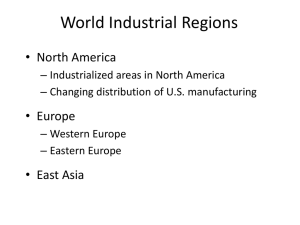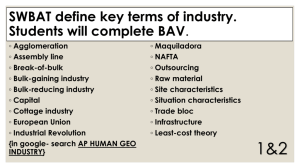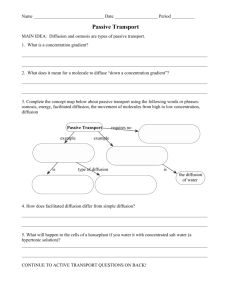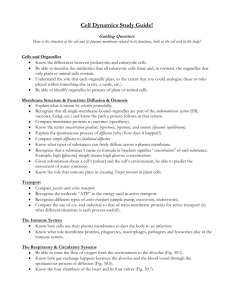Chapter 11 - Cobb Learning
advertisement
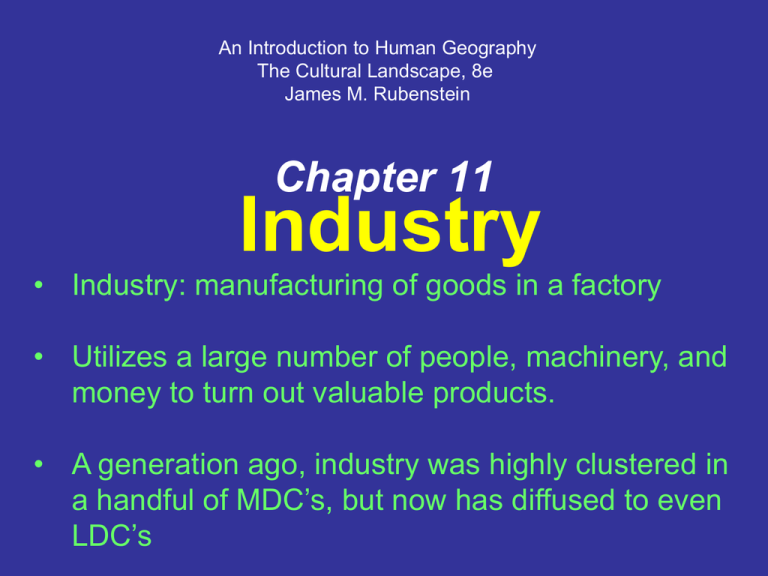
An Introduction to Human Geography The Cultural Landscape, 8e James M. Rubenstein Chapter 11 Industry • Industry: manufacturing of goods in a factory • Utilizes a large number of people, machinery, and money to turn out valuable products. • A generation ago, industry was highly clustered in a handful of MDC’s, but now has diffused to even LDC’s Where is Industry Distributed? • ¾’s of world’s industrial production is concentrated in 4 regions – 1. Northwestern Europe & 2. Eastern Europe – 3. Eastern North America – 4. East Asia • Less than 1% of world’s land is devoted to industry World Industrial Regions • Europe – European countries competed with each other – Western Europe:1 region – Eastern Europe: 6…4 in Russia, Ukraine, Poland & Czech Republic • North America – Happened later, but developed faster – Northeast U.S., Southeast Canada – 5% of land but 1/3 of people and 2/3 output • East Asia – Isolated from world markets – abundant cheap labor force – South Korea, Taiwan – Japan: highly skilled jobs at lower cost – China: largest labor force in manufacturing Europe • • • • • Industrial Rev: originated in UK and Scotland High concentration of skilled workers, mechanics, inventors Coal and iron ore: Steel!!!! Diffusion of railway system corresponded with IR (TRADE!) Rhine-Ruhr Valley, Mid-Rhine, Northern Italy Industrial Revolution Hearths Fig. 11-1: The Industrial Revolution originated in areas of northern England. Factories often clustered near coalfields. Diffusion of Railways Fig. 11-2: The year by which the first railway opened shows the diffusion of railways and the Industrial Revolution from Britain. Europe: Origin and Diffusion of the Industrial Revolution • The Industrial Revolution • Diffusion of the Industrial Revolution – Diffusion from the iron industry – Diffusion from the textile industry – Diffusion from the United Kingdom North America • Manufacturing in NE U.S.: iron and other minerals located here, first settlers here • Biggest markets are located here • Steel factories around Great Lakes • St. Lawrence Valley: hydroelectric power • Minimills for steel production: smaller, less process, one step as opposed to integrated mills: all jobs done at this mill to get final product Manufacturing Regions Fig. 11-3: The world’s major manufacturing regions are found in North America, Europe, and East Asia. Other manufacturing centers are also found elsewhere. Industrial Regions of North America Fig. 11-4: The major industrial regions of North America are clustered in the northeast U.S. and southeastern Canada, although there are other important centers. Manufacturing Value Change Fig. 11-5: The value and growth of manufacturing in major metropolitan areas in the U.S. between 1972 and 1997. Manufacturing Centers in Western Europe Fig. 11-6: The major manufacturing centers in Western Europe extend in a north-south band from Britain to Italy. Manufacturing Centers in Eastern Europe and Russia Fig. 11-7: Major manufacturing centers are clustered in European Russia and the Ukraine. Other centers were developed east of the Urals. East Asia • Isolated from other world markets: forced to use own resources, Japan imports natural resources • Japan: high quality, expensive products, low cost >>> workers paid less • All on the coast or island countries for trade • Few natural resources • Wealth gap between east and west coast (east is urban, west is rural) Manufacturing Centers in East Asia Fig. 11-8: Many industries in China are clustered in three centers near the east coast. In Japan, production is clustered along the southeast coast.


